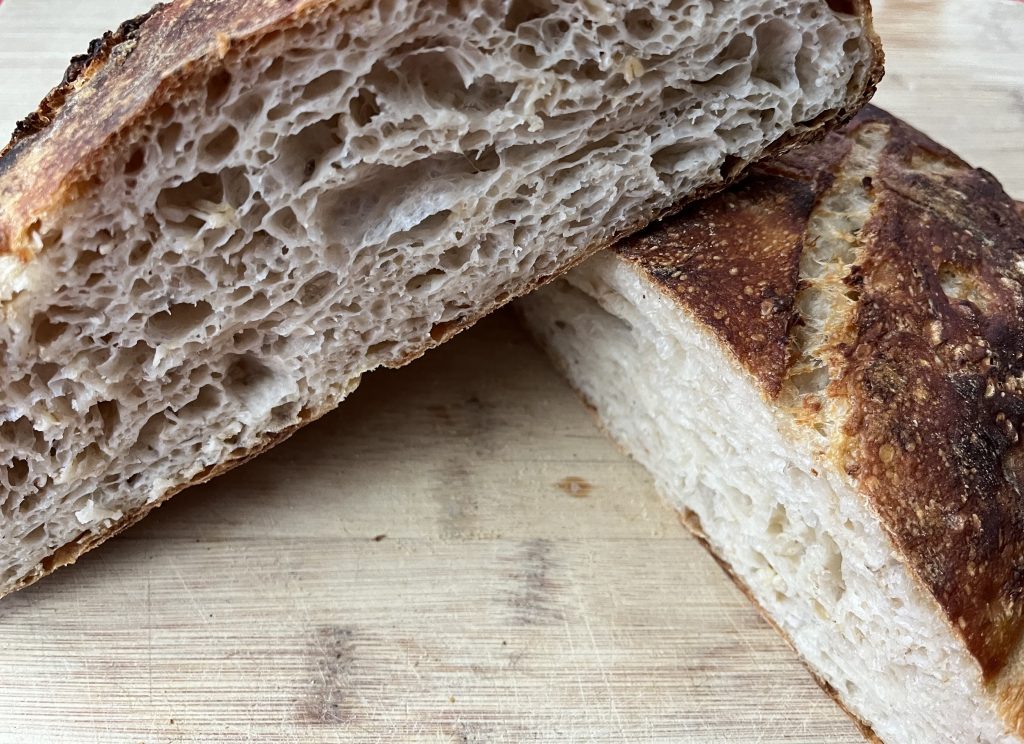
I spotted a recipe in Greg Wade’s Bread Head: Baking for the Road Less Traveled for a sourdough boule which included oatmeal porridge as an ingredient. Since Carol likes oatmeal for breakfast, I thought it would be worth trying and it was good. This is a 3 day recipe – make the levain on day 1, make the dough on day 2, and bake it first thing in the morning on day 3 to enjoy it for a latish breakfast.
Because the levain has a small amount of sourdough starter and is fairly stiff, it takes a while for it to become light and airy. A good idea is to start the levain on the morning of the first day, Depending on how it is going by the evening, it can be left on the counter overnight or can be put in the refrigerator overnight.
Here is an overall time line:
Step Description Time Cum Time
1 Day 1 – Mix levain 0:05 0:05
2 Ferment levain 10:00 10:05
3 Day 2 – Make the porridge 0:15 0:20
4 Allow porridge to cool 0:30 10:35
5 First mix 0:05 10:40
6 Rest 0:30 11:10
7 Second mix 0:05 11:15
8 Rest 0:45 12:00
9 First fold 0:01 12:01
10 Rest 0:45 12:46
11 Second fold 0:01 12:47
12 Rest 0:45 13:32
13 Third fold 0:01 13:33
14 rest 0:45 14:18
15 Fourth fold 0:01 14:19
16 Rest 1:00 15:19
17 shape and put in proofing basket 0:05 15:24
18 Proof in refrigerator 10:00 25:24
19 Day 3 – Preheat oven and combo cooker 0:30 25:54
20 Bake covered 0:30 26:24
21 Bake uncovered 0:15 26:39
22 Cool before cutting 0:30 27:09
The original recipe called for 330 g. of bread flour and 250 g. of first water. To increase the fiber in this bread, I made it with 165 g. of KAF high gluten flour and 165 g. of Flourish all-purpose flour and increased the first water to 275 g. The dough was very light and a bit hard to get into the Combo cooker to bake. I may want to use a circular silicon mat instead of parchment paper.
For the Levain:
78 g. bread flour
50 g. water
7.5 g. active sourdough starter
For the Porridge:
65 g. rolled oats (such as Quaker Oats Old-Fashioned Oats)
200 g. water
¼ tsp. salt
For the Bread:
165 g. KAF high gluten flour
165 g. Flourish all-purpose flour
275 g. Water (no. 1)
25 g. honey
7.5 g. fine sea salt
20 g. water (no. 2)
On the morning of Day 1, mix the Levain ingredients together in a container big enough for it to double. Mix them well until it forms a smooth dough. I usually use a 1 pint plastic cylindrical container used for take-out foods, and cover it with plastic wrap secured by a rubber band. In the evening of Day 1, evaluate how well the Levain is going. If nicely doubled and airy, put it in the refrigerator overnight. Otherwise leave it on the kitchen counter.
On the morning of Day 2, put the porridge ingredients in a small saucepan. Bring to a boil and reduce to a simmer and cook for about 4 minutes, until the oats are soft. Spread the cooked oats on a broad surface, such as a silicon mat, to cool to room temperature.
in a large doubling container, mix together the flours, water no. 1 and the honey with a dough whisk until everything is evenly combined. Cover and allow to rest for 30 minutes. Then sprinkle the salt on top of the dough and fold and stretch the dough by hand until the salt is evenly incorporated. Next sprinkle the water on top, and fold and stretch the dough by hand until the water is fully incorporated into the dough. Last add the cooled porridge, and fold and stretch the dough until it is fully incorporated.
Cover the doubling container and allow to ferment for 45 minutes. Then with a wet hand, fold and stretch the dough. Rest for another 45 minutes covered, and fold and stretch the dough a second time. Rest for 45 minutes and then fold and stretch the dough a third time. Rest for 45 minutes, and then fold and stretch the dough a fourth and last time. Rest for an hour covered. At this stage, it should be very light and airy.
After an hour, generously flour a work surface and the top of the dough. Flour the surface of a banneton. (I use a cloth liner and rice flour.) Empty the doubling container onto the floured work surface and form it into a boule shape and put it in the prepared banneton. Put the banneton and dough into a large plastic bag, seal it and put it in the refrigerator overnight.
The next morning, put a heavy oven-proof pot and lid (~5 quart in size) separately into the oven and heat to 450 degrees. After about 30 minutes when everything is preheated, carefully remove the pot from the oven and turn the banneton upside down over the empty pot. (If using the combo cooker, score the top with a lamé or sharp knife in a hashtag pattern.) After the dough falls into the pot, put the lid on and bake for 30 minutes. Remove the lid and bake for another 15-20 minutes until the crust is nicely browned but not burned. Remove the pot from the oven and with a spatula, remove the bread from the pot and allow to cool on a wire rack for at least 30 minutes before cutting it.

